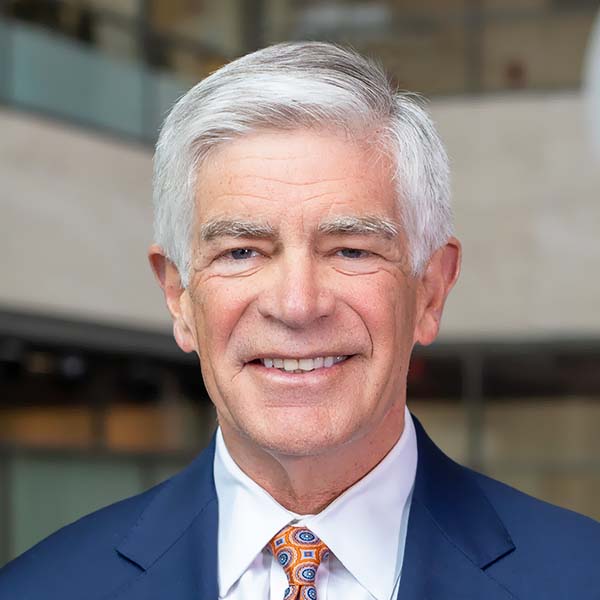Good morning! It’s great to see you all here. I was reminded before today’s breakfast that I was here for the last in-person event that the Main Line chamber hosted prior to the pandemic, back in February 2020.
And it’s great to be back. I plan to speak a bit about the economic outlook for the country and our region, and then we can get to your questions, which I’m really looking forward to.
But first, I need to give you my standard Fed disclaimer: The views I express today are my own and do not necessarily reflect those of anyone else on the Federal Open Market Committee (FOMC) or in the Federal Reserve System.
How We Got Here
If we take a step back, it’s quite remarkable how much has transpired since we were last together. First and foremost, of course, is the humanitarian tragedy that our country — and our world — has endured because of the COVID-19 virus over the past three years. More than 7.5 million people globally have perished from the virus, including more than 1 million of our fellow Americans and 50,000 Pennsylvanians. This is a public health catastrophe on a global scale that is unprecedented in any of our lifetimes.
The tribulations of the U.S. economy over this period have been startling as well. During the early part of the pandemic, the national economy suffered its largest contraction in recorded history as the virus spread and state and local governments shuttered businesses that they deemed nonessential. Tens of millions of Americans were thrown into joblessness in one of the sharpest recessions in American history.
That downturn was followed by a period of extraordinary economic growth as states loosened restrictions and, with astonishing rapidity, highly effective vaccines against COVID-19 were developed and deployed.
But even as the economy came roaring back to health, scars were visible. Many older Americans had opted to retire at the onset of the pandemic, leaving labor force participation below where it was before COVID-19 arrived on our shores. Supply chains were badly damaged by the virus itself as workers fell ill, and by government lockdowns, which shuttered factories for extended periods. This left crucial items like computer chips in short supply. Meanwhile, large doses of fiscal spending from the federal government and accommodative monetary policy from the Federal Reserve stoked demand. This led to a phenomenon known colloquially as “too much money chasing too few goods” and the highest inflation in four decades.
Where We Are Nationally
High inflation is a scourge, leading to economic inefficiencies and hurting Americans of limited means disproportionately. I find it particularly disturbing that life’s true essentials like groceries, fuel, and shelter have skyrocketed in price.
The Federal Reserve is absolutely committed to bringing inflation back to our 2 percent target.
And we’re doing that by adjusting our monetary policy. Last year, we raised the target for the federal funds rate to between 4.25 percent and 4.5 percent. That was a significant move, and a very fast one, given that we started the year at about 0 percent. I expect that we will raise rates a few more times this year, though, to my mind, the days of us raising them 75 basis points at a time have surely passed. In my view, hikes of 25 basis points will be appropriate going forward.
At some point this year, I expect that the policy rate will be restrictive enough that we will hold rates in place to let monetary policy do its work. We are also shrinking our balance sheet, which is removing a significant amount of accommodation in and of itself.
Our goal is to slow the economy modestly and to bring demand more in line with supply. The Federal Reserve obviously can’t fix problems like supply chain issues, or an endemic shortage of workers, though it does seem like these problems are finally easing a bit. But we can affect demand by making it more expensive to borrow money. And that’s clearly already happening: We’re seeing unmistakable signs of a slowdown in the most interest-rate sensitive parts of the economy, like housing.
What’s encouraging is that even as we are raising rates, and seeing some signs that inflation is cooling, the national economy remains relatively healthy overall. In parts of 2022, the economy grew modestly even as we were tightening monetary policy substantially. Although inflation is biting, many Americans are still spending — even if they dip into their savings to do so.
We’re seeing a healthy recovery in those sectors that suffered most during the pandemic, like leisure and hospitality, while some sectors that built up healthy order books like manufacturing, are cooling somewhat. I do remain concerned about commercial real estate, as the embrace of remote and hybrid work is clearly dampening demand for office space in central business districts and suburban office parks.
I’m most pleased that the labor market remains in excellent shape. Last year, the U.S. economy created 4.5 million jobs, and while we are seeing scattered layoffs in certain segments like tech, there is little evidence of a major downturn in the job market. In fact, a record number of Americans are employed. And indeed, the national unemployment rate is exceptionally low at 3.5 percent.
Where We Are Locally
Local conditions look broadly similar. Much like the national economy, the Philadelphia area’s economy reflects weakening conditions in business and interest-rate sensitive areas such as housing, but maintains significant strengths, particularly in the labor market. Payroll growth continues to chug along, unemployment claims have stayed low, and the unemployment rate has continued to drop. In fact, in the Philadelphia metropolitan statistical area, the unemployment rate stands at 3.8 percent — effectively, full employment. As of the third quarter of 2022, wages were up nearly 5 percent year over year in the Philadelphia–Reading–Camden region.
Of course, even in a hot job market, some positions remain more in demand than others. According to an analysis of job listings for the Philadelphia area, some of the most frequent job ads are for registered nurses, retail salespeople, software developers, and customer service representatives, reflecting continued hot demand in health care, tech, and retail. I continue to see biotech as a key growth industry in our region as well, with firms unable to build wet labs fast enough. That’s driving labor demand not only for PhDs and college graduates, but also those with high school diplomas.
Now, our region’s strengths are vulnerable to ongoing challenges. One obvious weak spot is manufacturing. Responses to the Philadelphia Fed’s most recent Manufacturing Business Outlook Survey suggested continuing declines in the sector. The survey’s indicators for general activity, new orders, and shipments were all negative, and manufacturing firms reported a decline in employment, on balance.
Housing is also weakening considerably, certainly in part due to higher interest rates. Home price growth in Philadelphia County is trending downward and was only around 5 percent year over year in September 2022. Nearby counties in Pennsylvania and New Jersey have higher home price growth, ranging between 8 percent and 20 percent, respectively, well below the huge gains logged during the pandemic. According to Zillow, the share of listings with a price cut in the Philadelphia metro area has increased over the past several months and was up by more than a quarter in November. In October, meanwhile, the median days on the market for a house for sale in the Philadelphia metro area was 38 days. This is closing in on the typical prepandemic figure, which was 41 days, showcasing a softening in conditions. The days of houses selling before they are even listed are in our rearview mirror. So, sorry to all the realtors in the audience this morning.
Where We Are Going
Also in the rearview mirror, I expect, are the eye-popping inflation readings of 2022. With monetary policy doing its work, supply chains healing, and excess demand running off, I forecast core inflation to come in at around 3.5 percent this year — well over our 2 percent target, but suggestive of clear movement in the right direction. Core inflation should fall to 2.5 percent in 2024 and then back down to 2 percent in 2025.
GDP growth will be modest, but I’m not forecasting a recession. The labor markets are simply too hot to indicate a significant downturn at this point. I expect real GDP growth of about 1 percent this year before climbing back up to trend growth of about 2 percent in 2024 and 2025.
Lastly, I do think we will see a very slight uptick in unemployment, probably topping out at about 4.5 percent this year, before falling back toward 4 percent over the next two years. It’s an underrated advantage that the Federal Reserve is taking on inflation from a position of such labor market strength.
Conclusion
In sum, the Federal Reserve is committed to bringing down inflation and to maintaining the conditions for a healthy labor market.
Thanks so much for having me. Let’s hope it’s not another three years before we see each other again. Now, let’s get to your questions.

